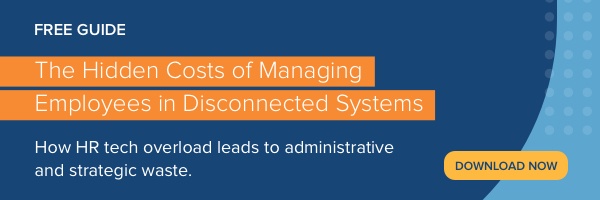
Reliable HR metrics help you understand the success of people initiatives, as well as their associated costs. With good metrics, you’ll also have better insight into what’s working and what needs improvement, so you can establish priorities and track your progress. In 2021, tracking key HR metrics will also help you understand the continued impact of the COVID-19 pandemic on your workforce.
HR Metrics That Matter in 2021
No matter the size or stage of your organization's growth, there are specific HR metrics that are always relevant. They help you measure the overall employee experience and identify areas for improvement. Key metrics include the following:
1. Employee Engagement
Engagement is the degree to which an employee is committed to giving their best effort at work, and it is often hard to achieve. According to Gallup, only 36 percent of employees are engaged at work. Because engagement impacts employee performance, it’s a critical metric for understanding the programs or activities your organization should continue or suspend in order to help employees perform at their best.
Using employee engagement surveys, you can get a snapshot of employee opinions of their work, manager, coworkers, and the company as a whole. Surveys can also help you gauge how well employees are responding to changes in culture over time.
2. Time to Hire
According to Yello research, the average time to hire is 3-4 weeks, but candidates typically expect an offer within a week of the first interview. Although your time to hire depends on many factors, including the length of your interview process and the supply of qualified candidates, the shorter the time it takes to fill a position, the better. A shorter time to hire allows you to keep candidates engaged through the hiring process. It also helps you avoid the recruiting and lost productivity costs that come from having a position go unfilled for a long period of time.
3. Cost Per Hire
Understanding the cost per hire helps you see how much your organization spends to fill each position. This HR metric helps future workforce planning and budgeting, and it can also tell you if you’re spending more or less than you think you should.
To calculate the cost per hire, divide the total cost of your hiring process by the number of new employees. Be sure to include costs such as:
- Job postings
- Staffing agencies
- Recruiters’ time
- Candidate sourcing expenses, such as chatbots and careers page maintenance
4. Workforce Diversity and Demographics
To support your diversity and inclusion goals, you need to understand your starting point and progression over time. Tracking this HR metric is helpful for company-wide EEO and diversity reporting, and it gives you an overall sense of your ability to attract and retain a diverse workforce.
There are many ways to track workforce demographics, including by gender, ethnicity, age, and length of tenure within your organization. To measure your progress against diversity goals, you can also conduct employee surveys to track employee views of your diversity and inclusion efforts.
5. Voluntary Turnover Rate
Not all turnover is bad, particularly when an employee is a poor fit with your culture or isn’t meeting performance standards. Understanding voluntary turnover helps you know what motivates good people to leave and what you can do to keep them.
To calculate your voluntary turnover rate, divide the number of employees who leave voluntarily by the total number of employees. You can track this number over several quarters (or ideally, over several years) to give you an idea of where changes are needed to improve retention. For deeper insights, you can also track early turnover. Measuring the number of employees who leave within their first year at the company can highlight issues that may be turning off new hires early in their tenure.
6. Employee Absence Rate
Although some degree of employee absence is natural, unscheduled absences or growth in unforeseen absences over time can be a sign of a problem with employee morale, stress, or some other issue. A CareerBuilder study found that 40 percent of employees who called in sick did so for a reason other than illness.
By understanding your employee absence rate, you can get closer to finding the possible cause. Calculate this metric by dividing the number of unscheduled absences by the number of employees. You can also track employee absences by manager to pinpoint issues that may be unique to a particular team.
7. Overtime Expense
For some roles, overtime is a regular occurrence. In fact, some employees welcome extra overtime as a way to increase their earnings. But when overtime becomes excessive, it can increase your payroll expense considerably.
Understanding your overtime expense can help you identify areas where process improvements or systems can keep overtime at a manageable level. Once you know how much overtime is costing you, you can determine if it would be more or less costly to hire additional employees as an alternative.
8. Employee Productivity
Measuring employee productivity isn’t just for positions with a physical output, as in manufacturing. For employees in service roles, productivity can also be calculated by measuring performance against goals in a given quarter. Once you have a better idea of employee productivity (and changes over time), you can use those metrics to drive employee performance ratings and incentive compensation.
9. Training Costs and Overall Training Effectiveness
These two HR metrics are best considered in tandem. Together, they can help you understand your company’s return on training investments. Although measuring training costs is relatively straightforward, you gain more insights from tracking your training spending over time. Rising training costs without an equivalent rise in employee effectiveness and skill development likely means you should change up your training content or training delivery methods.
HR Metrics to Track for Understanding Pandemic Impacts
In addition to the above HR metrics, a few others hold particular value as you consider the impact of the COVID-19 pandemic on your organization. Here are some additional HR metrics that can help you manage your workforce in 2021:
10. Rehire Rate
If your organization was one of the many that had to pursue layoffs or furloughs due to the pandemic, you may be returning former employees to the workforce. Tracking your rehire rate (the number of hires who are former employees) can help you see how often you rehire rather than bring in brand new hires. Because rehiring former employees often takes less time and doesn't require investing in job postings or recruiters, tracking this metric will also highlight changes in your time and cost to hire.
11. Benefits Enrollment Rate
Healthcare is important at any time, but employees may enroll at higher rates during the pandemic than in earlier years. In a Prudential survey, 75 percent of employees said they believe access to employer-provided benefits is more important than ever before because of the pandemic. By tracking your benefits enrollment rate, you can see how many employees are enrolled in your plans and which benefits are most in-demand for 2021.
12. Usage of Employee Assistance Programs (EAP)
As a result of the pandemic, employees may seek mental health support due to stressors such as their physical health, the sudden shift to remote work, or general worry about the pandemic. According to The National Council, 52 percent of behavioral health organizations saw an increase in demand for mental health services in 2020 due to the pandemic.
Employees who need support for their mental wellbeing may seek additional help through your company-provided EAP, which can provide referrals or other mental health resources. Track your organization’s EAP usage to determine the rate at which employees are using available services. If the EAP usage rate is low, you can take steps to make sure employees know what’s available and how to use the service.
Track HR Metrics for Better Workforce Management
Managing your workforce effectively requires programs and activities that help employees stay productive and engaged. By tracking these key HR metrics, you can understand the success of those programs and get actionable data to drive better decision-making.
Instead of trying to cobble together workforce metrics from multiple HR systems that often work in silos, you can leverage an integrated HR and payroll system for consistent reporting and powerful analytics. To learn more, read our e-book, The Hidden Costs of Managing Employees in Disconnected Systems.

